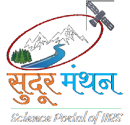Snow cover plays an important role both globally and regionally as it reflects a large portion of the insolation, therefore keeping the Earth’s radiation budget in balance. Snow cover is important for local water availability, river run-off and groundwater recharge, especially in middle and high latitudes. Glaciers are mass of snow, ice, water and rock debris slowly moving down a gradient under the influence of gravity. Glaciers are formed due to recrystallization and metamorphism of naturally fallen snow on land surface.

Figure 1: Snow clad Samundra Tapu glacier viewed from Resourcesat- AWiFS data ( Top image acquired on 23 Jan. 2024) and Sentinel-1 SAR data (Bottom image acquired on 20 Jan. 2024 in VV polarization). (Courtesy: VEDAS SAC web portal).
Synthetic Aperture Radar (SAR) is known to be very useful when optical remote sensing is obstructed with clouds. It is equally important in detecting the moraine-dammed lakes (MDL) particularly when they are frozen and covered with snow. Figure 1 shows Samudra tapu glacier in optical and microwave region observed from AWiFS multi spectral camera and Sentinel-1 Radar. Samudra Tapu is the second largest glacier in the Chandra sub-basin, Himachal Pradesh, India. Moraine dammed lake is seen in white colour in optical data due to snow cover during winter and looks dark in Radar image due to interaction of radar signal with lake water at the base of snow covered surface.
Depth of penetration of SAR signal depends on the wavelength and relative permittivity of dry snow, which further depends on snow density. Penetration depth over snow high is high at higher wavelength. As per Singh et al. 2015, penetration depth can vary from 4 to 22 m for 0.1–0.5 g/cm3 snow density at the C band. Satellite based observations from C band SAR provides valuable information on signature of MDLs buried under snowpack in the Himalayan region
Advanced Wide Field Sensor (AWiFS) and Sentinel-1 data visualization was carried out using VEDAS portal (https://vedas.sac.gov.in) and the article is contributed by Dr. Raghavendra Pratap Singh, Indian Institute of Remote Sensing, ISRO, Dehradun, India.
References
- Singh S. K. , Rajawat, A. S., Rathore, B. P.,. Bahuguna, I. M. and Chakraborty, M. (2015), Detection of glacier lakes buried under snow by RISAT-1 SAR in the Himalayan terrain. Current Science, 109, 1728-1732.



